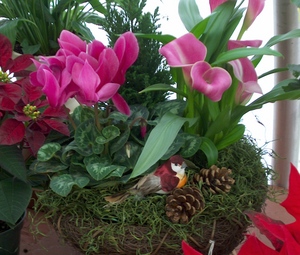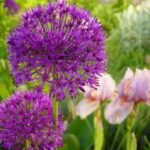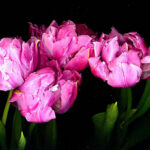These bulb plants are native to the base of the Himalayas where the summers are cool. The original species have small rounded leaves and small sporadic flowers that resemble up-side-down tumblers. These species have been hybrid to the point where the leaves and flowers are large and the plant gives a spectacular show of color all winter long in a bright spot in the home. Like all flowering plants, Cyclamen need a lot of light all day or early morning direct sun before 11 a.m. or late afternoon direct sun after 3 p.m. to continue the abundance of flowers.
Unlike the spring-flowering bulbs that only flower for a few weeks, cyclamen will continue to send out buds all through the season as long as the light is bright and the plant has the proper amount of water and a good supply of fertilizer to give it what it needs to build the new flowers. This flower cycle is usually September through May, but many plant lovers will continue the flowering time through the summer.
Cyclamen have a yearly cycle like any other bulb plant, but it has the longest flower cycle of all the bulb houseplants. When you first bring home a new plant that has lots of flowers and buds, take time to notice how the flowers are structured and how the stems come out of the center of the leaves off the top of the bulb that is just below the surface of the soil. It is very important not to pour water into the center where the leaves come out because this may often lead to a fungus which can rot the bulb. Add the tepid water around the outside of the leaves at the top of the pot. I never recommend watering the plant from the bottom and allowing the pot to sit in water. This can also lead to root rot and destroy the plant very quickly.
I have worked in tropical greenhouses for over 37 years and Cyclamen are one of my favorite plants because of the beauty it presents all winter long. If given just a bit of care each week, these plants will reward you with an abundance of beautiful and colorful flowers all winter long.
These are the particulars that cyclamen need to perform their best:
Water
Give the plant a drink of tepid water when the surface becomes just slightly dry. They do not like too much water. Fill the entire pot until the water comes to the top rim and let it dry again until the soil becomes dry to about 1/4 inch for four inch pots and 1/2 inch down for six inch pots. Never water the plant until water pours out the bottom. This leeches the soil and takes out important nutrients the plant needs to continue flowering. Be sure to check the plant daily for the first couple of weeks so the plant will get the correct amount of water. Always remove any foil or plastic pot cover that comes with the plant. I often place the green or black growers pot into a slightly larger ceramic pot that covers the plastic completely. I suggest using a ceramic pot that has a drainage hole at the bottom to prevent the plant from sitting in water. I sometimes use a metal or ceramic pot that does not have a hole and put a 1/2 inch layer of small pebbles in the bottom. This will keep any excess water away from roots, and can add a bit of humidity around the bottom of the foliage. Just be sure to check often to make sure the water level never goes over the top of the stones.
Light
It is very important to give these plants the proper amount of light so they can use the nutrients in the soil to build new leaves and flowers continuously. These plants will not flower as profusely if they are in lower light levels. Most of these plants come with a care tag in the pot that gives basic generic instructions. I have read these tags that say moderate to low light, but never in all my years growing these plants, have I never seen them do well in moderate light. (to understand the levels or light according to what a plant needs, see the article “Growing Houseplants according to what the Plant Needs.”)High light close to a east, west or slightly away from a south-facing window will give the plant all the light it needs when the days become short and sunlight is scarce.
Fertilizer
Most people do not realize that the plant uses the nutrients in the soil quickly during the flower cycle and these nutrients need to be replaced for the plant to continue producing the colorful display. It is important to give a very weak solution of a high phosphorous fertilizer, one that has a higher middle number on the label. All plants use phosphorous to build the cells that produce strong root systems and flowers. Plants flower when the root system fills the pot and forces it into its reproductive cycle. After all, this is what flowering is all about. When a new plant arrives at your home. it is in full bloom because it has spent the last 13 months growing and developing to this stage. It is up to us to continue this flowering, or the plant will begin to form seed pods.
Begin using a weak solution of water soluble fertilizer about three weeks after purchasing the plant, and continue until the end of April. If done correctly, the plant will give you color and beauty all winter long.
Maintenance
With the proper light and water, keeping the plant looking its best is as important as the fertilizing. The plant will at times have some leaves turn yellow. Be sure to remove any leaves that are torn, yellowed, or spotted. With the fertilizer, the plant will grow more leaves to replace those it looses. As the Flowers go by, they will start to loose color and the center at the base of the up-side-down flower will darken. Remove these stems down to the base of the bulb. The pant will continue to produce more flowers as the old ones go by. If left on the plant, a small round seed pod develops and the plant will not produce as many flowers while energy is channeled into seed production.
For the adventurous indoor gardeners, allowing at least one flower to produce a pod is a challenge to grow a plant into maturity. You can allow one flower to form a seed when it is toward the end of the flower cycle in March. From seed, it takes about 13 months for the plant to mature enough to produce flowers. Patience is a strong key to this method of reproducing your plants.
TEMPERATURE
I stated earlier that the plants were first discovered at the base of the Himalaya Mountains where the summer temperatures are cool. Thus the plant needs cooler temperatures to thrive. Humidity is not as important to the plant as temperature. The plant will wilt in very warm areas and you may wake up to a plant with leaves and flower stems cascading down around the pot. Once the plant is placed in a cooler location, it will pick up again, but some leaf and flower loss usually occurs. The best ranges are between 55-55 degrees at night to 75-80 degrees in the daytime. Above 80 degrees, the plant will often wilt.
Cold air from drafty windows is also a cause for concern. Too cold air will kill the plant very quickly. If you purchase a plant when the outside temperatures are below 50 degrees, be sure to put the plant in a paper bag–not plastic–for insulation against the cold air. Plastic transfers cold very quickly to the plant’s leaves. All too often, people come in to me with a very dead plant they purchased the day before. As soon as thy tell me that the plant left the store unprotected, I tell then that is what killed it. All too often, people have left their plant in the car when the temperatures are below freezing for even a short a time as 10 minutes only to wake up to a dead plant the next day. Remember that these extreme temperatures will kill unprotected plants.
Resting
If given all the light, proper water, and continuous fertilizer the plant needs, it will continue to produce all season long. If the conditions are what the plant loves, this cycle can continue on through the summer. As in all bulb species, the plants need time to renovate after putting so much energy into producing flowers for several months. Because Cyclamen are cool weather plants, the summer is the best time to rest the plant and allow it to refill the bulb with nutrients. If the plant was fertilized ( I use the term fertilizer rather that plant food because this is an important distinction in nutrients for plants, See “Fertilizer versus Plant Food”) to meet it needs, then the plant will spend the hot months rebuilding the leaves and flowers for the next flowering cycle.
This the time to allow all the top growth to die down and by giving the plant less water, decreasing it until all the top growth dies. Place the plant in a cool dark area–I often place the potted bulb in the basement during the summer. Leave the plant in its pot and only water once a month to keep the root system alive. Do not allow the soil to dry completely.
Transplanting
After the plant has rested for three to four months, it is time to transplant into a slightly larger pot. If you go too big the plant will spend all season filling the pot with roots. Be sure to use a well-draining potting soil that does not clump when you grab a fist full and squeeze tightly. The ball of soil should fall apart as soon as you open your fist but water should not sit on top of the pot after watering. A good planting medium is extremely important for the health of all potted plants.
Once reported, place the plant in good light and water well. Allow the surface to dry a bit before watering again . Once new growth appears, begin fertilizing and the cycle will begin again.
As stated, some people allow their plants to continue to flower all year continuously. This will eventually shorten the life span of the plant and once signs of dying back occurs after years of flowering, it cannot be revived and will die.
Here are some of the trouble signs to watch out for with Cyclamen:
Yellow leaves
All plant loose leaves as they age and the plant grows in new ones to replace those that they loose. But if the plant has leaves that turn yellow quickly and frequently, this is a sure sign of trouble. It may be any one of a number of things that are causing this: too much water, too little water (unusually accompanied by wilting), too warm temperatures (leaves turn yellow after the plant pulls itself up), too cold temperatures usually cause by a draft of exposure to cold (this will kill the plant quickly), or a combination of two or more of the above. The closer the environment is to what the plant needs to thrive, the better it will grow and flower.
If the leaves develop brown spots on the leaves as they yellow this is a sign of too much water. If the spots are ringed with yellow, this is a sign of salt burn cause by inaccurate fertilizing. If holes appear anywhere in the leaves, a little bug is eating its way to heavenly bliss.
Cyclamen mite is one of the few insects that threaten the life of a cyclamen. They cluster in the center of the plant causing stunted growth and very yellow leaves. Most insecticides have little effect on cyclamen mites and I usually recommend throwing out the plant but not into a compost because the insects will make it through the winter and end up in your garden. cyclamen mites will also infest African Violets.
If you would like more information about your houseplants and how to allow them to thrive in your interior conditions, please contact me through this site.







